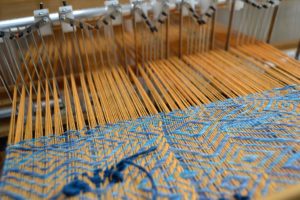 There’s a saying that ‘when you don’t know what to do, do what you know.’ It’s more about maintaining a hold on life and dealing with suffering and as a general mantra for holding yourself together. But it works, for me, even when I am doing what I know…in my case – weaving.
There’s a saying that ‘when you don’t know what to do, do what you know.’ It’s more about maintaining a hold on life and dealing with suffering and as a general mantra for holding yourself together. But it works, for me, even when I am doing what I know…in my case – weaving.
So I’m approaching this reed experiment with some of what I know and going from there. In this particular adventure I am using the Rail Reed made by Estonian weaver Kadi Pajupuu. The reed is made up of units which concertina in and out to change the sett of the weave as you weave. I think it is a great tool.
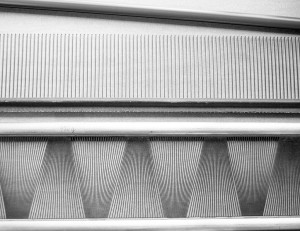
I’m weaving with some experience in distortion with the Saori comb reed, ondule (fan)reed and the no reed weave. They each have advantages and disadvantages and are specifically easier for some types of effects depending on how they change the sett. For example, with the Saori comb reed the movement of the warp threads is utterly manual so you can do what you like when you like, then go back to using the conventional reed at any time. Totally flexible and able to add the distortion insitu at any time. This is because the reed has a removable cap and can be placed in and out of the weaving as desired.
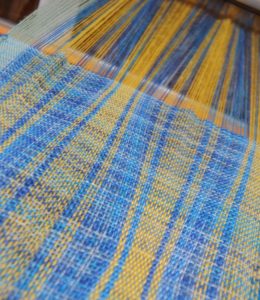
The Ondule or fan reed is a beautiful reed. Long used in Europe and Japan. It can be made to specific setts and angles. Once the reed is threaded for the project, it stays. Although, you can get a conventional sett without distortion if you beat the fell in the middle of the reed. I’ve only used it once and without adding any extra paraphernalia to the loom I ‘eyeballed’ the beating position each time I placed the beater to the fell of the cloth, moving the reed up incrementally then back down again to achieve the fan shaping on the cloth.
I know that distortions are more obvious with a highly contrasting colour in the warp and weft and also warp stripes to outline the distortion effect. But with the Rail Reed I wanted a patterning of some sort too. I’m using a 20 shaft point will and 4 shafts reserved for the selvedges in this first experiment. I was also aware of a need to lock and secure areas that seemed a bit too wide in sett. I’m using cotton warp and ramie weft so for this I added some wool inlay and some shadow box plain weave in these areas. Perhaps I’m over thinking it. The Rail Reed also allows complete movement of whole units of warps which is something the other types of reeds don’t do. This means, for example, that you can change the width and curvature of the selvedge and within the cloth dynamically.
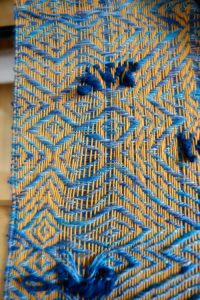 I was pretty happy with the first result. I felted the wool in the finish and although the cloth was quite heavy it had good drape due to the twill structure. Many experiments with the Rail Reed have been in wool because of the fibre’s ability to meld and distort on finishing. But I’d like to keep working with cellulose or silk. I’m now going to re-thread the weave and extend some plain weave into some areas.
I was pretty happy with the first result. I felted the wool in the finish and although the cloth was quite heavy it had good drape due to the twill structure. Many experiments with the Rail Reed have been in wool because of the fibre’s ability to meld and distort on finishing. But I’d like to keep working with cellulose or silk. I’m now going to re-thread the weave and extend some plain weave into some areas.
The sett distortion in these reeds can also develop puckers which are another good reason to use them. Anything that breaks into a bump is exciting. I like to play with new developments in handweaving if only because when we all get to experiment we all come up with more puzzles. Congratulations to Kadi Pajupuu. Reeds are a great tool for designing cloth even in their regular form. Give them some action and they do more.
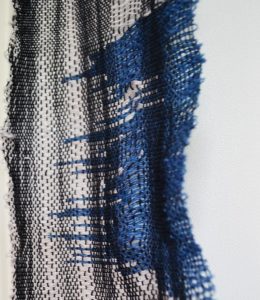
And then there is the Noreed method that I learnt from Kenzo Jo of Saori no Mori. It is the most organic and freestyle method of them all. But there is no turning back to the original intended sett of the cloth. You totally commit to the free sett. Very nice indeed.
What is sett in weaving?
If you are new to weaving you may be wondering about sett. The sett of the cloth is the number of warp threads in the reed to the centimetre (or inch). For example, the Saori loom comes with a 5 dents (or slots) per centimetre reed. This is written as 5dpc. If you place one warp thread in each of the dents you will have a uniform and conventional sett for weaving. But you can place more than one thread in each dent or even leave some empty to start working in outlandish sett ways.


Leave a Reply